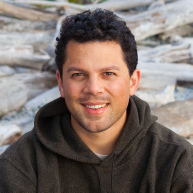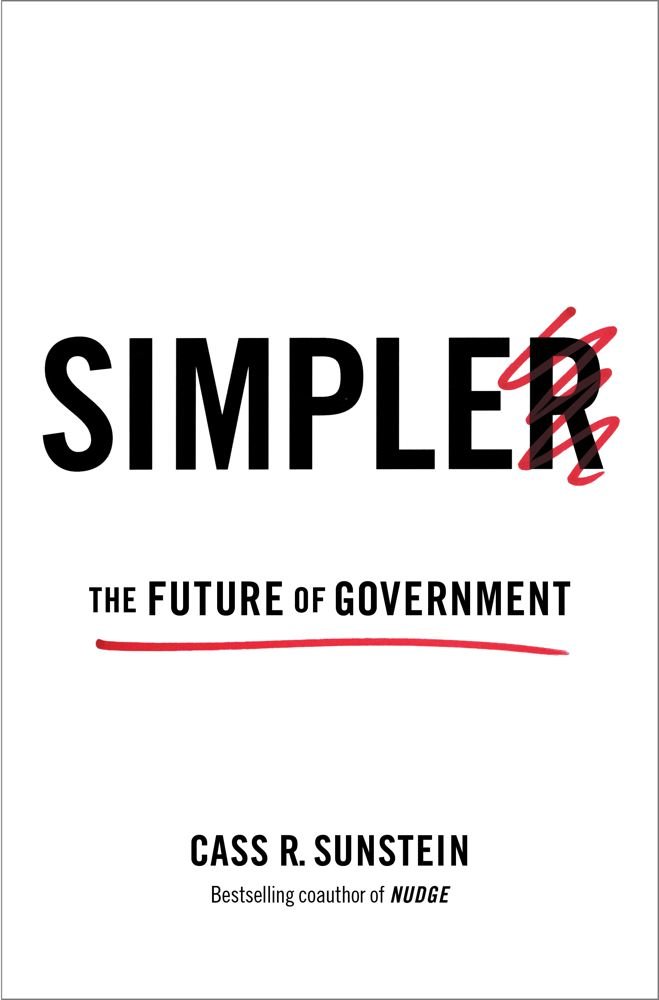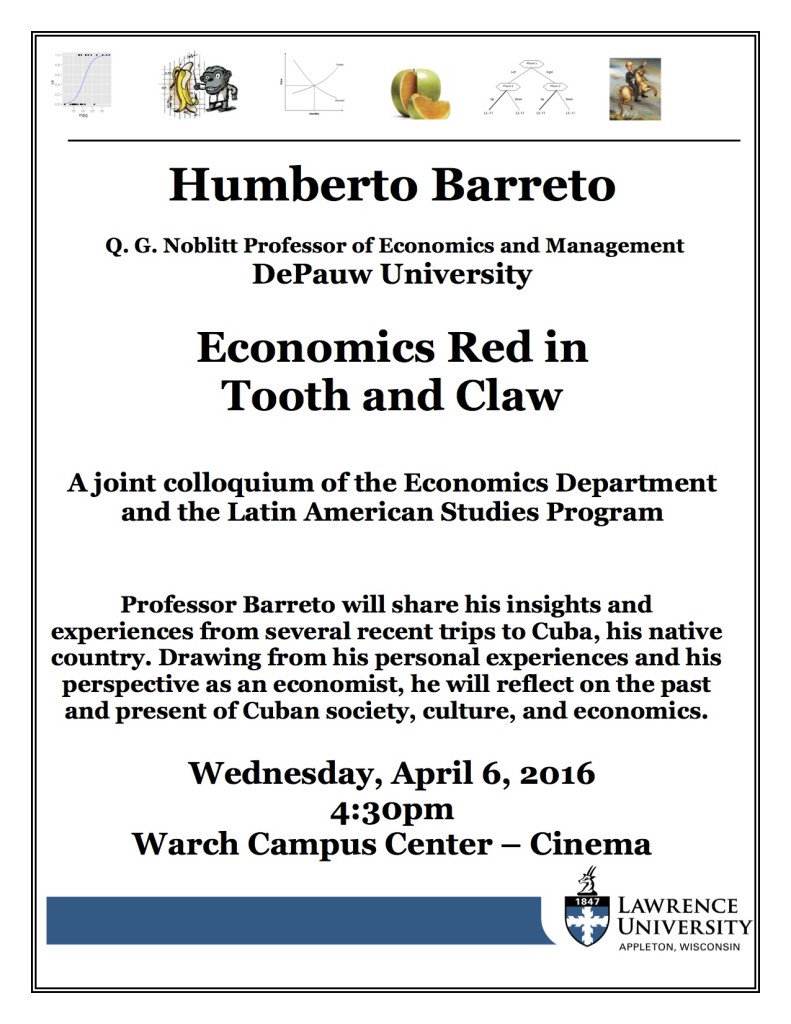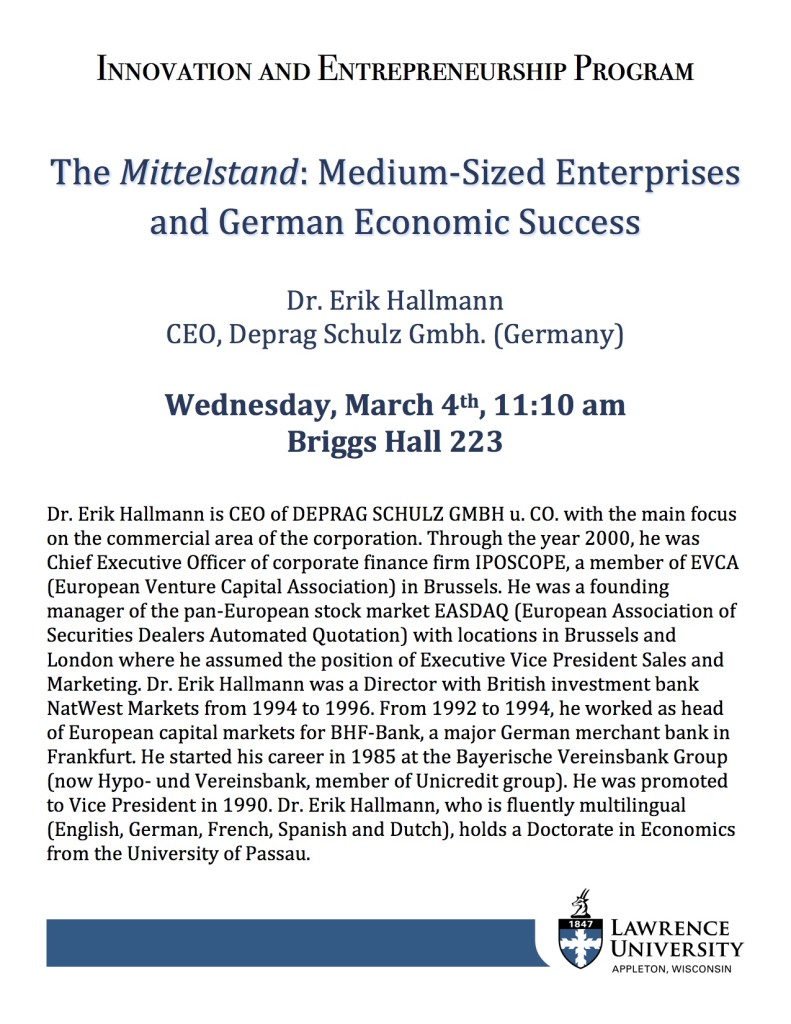The title of the talk is Economics Red in Tooth and Claw, and it’s about Cuba.
Author: Adam Galambos
Innovation in Everything
What distinguishes the ‘scientific’ economist from all the other people who think, talk, and write about economic topics is a command of techniques that we class under three heads: history, statistics, and ‘theory.’ The three together make up what we call Economic Analysis.
That’s Joseph Schumpeter in Chapter 2 of his famous History of Economic Analysis. He believed that economics programs should emphasize and connect all three of those approaches. Those of us in ECON 405, The Economics of Innovation and Entrepreneurship, have been working to do just that, or at least the history and theory bit. To take a break from immersing themselves in the history of innovation and mathematical models of innovation and entrepreneurship, students have been exploring innovation in a variety of fields, and recording their journeys weekly on a blog. So, you can also learn about theatrical innovation, microfinance in Pakistan, the habits of the poor, private equity and innovation, innovation in the construction industry, multisided markets, telematics, or big data and consumer goods. Enjoy!
A grave note

I had coffee with Tim Dahlstrom ’16 a couple of days ago, which is not very unexpected, except that we had it in a cafe with a view on the Kremlin. I am here visiting family, and he is here practicing his Russian and prepping for the GRE. He shared with me afterwards this photo, which he recently took here in Moscow: It is the grave of a Nobel prize-winning mathematical economist, obviously from Russia. This should probably be enough for you to guess the name, but if you need more, here is a cogent Austrian perspective on his prize. Tim remembered him from the Red Plenty reading group from his freshman year.
Data Science for Humans
The last Economics Colloquium of the year, at 4:30 on Wednesday, May 27th, Steitz 102:
Data Science for Humans
Shilad W. Sen Macalester College,Associate Professor, Mathematics and Computer Science
Data scientists mine massive datasets to help software understand our t astes, needs, and routines. Want to become a data scientist? Many new data science degrees incorporate coursework in statistics and computation. However, most programs focus shallowly on data, without deeply connecting to existing domain knowledge in the fields in the social science, humanities, marketing, etc. Continue reading Data Science for Humans
astes, needs, and routines. Want to become a data scientist? Many new data science degrees incorporate coursework in statistics and computation. However, most programs focus shallowly on data, without deeply connecting to existing domain knowledge in the fields in the social science, humanities, marketing, etc. Continue reading Data Science for Humans
Dr. Hallmann on German Economic Success
Interdisciplinary Area in Innovation and Entrepreneurship
Over the past six years, a group of Lawrence faculty members have developed several courses and course modules in innovation and entrepreneurship. By now, several hundred Lawrence students have taken those courses. The Lawrence faculty has now voted to create a formal academic program in innovation and entrepreneurship: the Interdisciplinary Area in I&E. Students from all majors with an interest in innovation or entrepreneurship are invited to explore the new IA. The rest of this post gives a general idea of the new IA. Look for more details on the I&E website in the near future. Continue reading Interdisciplinary Area in Innovation and Entrepreneurship
Learn about financial services from Lawrentians
The next Lawrence Scholars in Business event is coming up this Saturday, February 1st. The topic is financial services, and the panelists will be
- U.S. Bank – Michelle Bauer ‘87
- Morgan Stanley – Michael Martino ‘80
- Kepos Capital, L.P. – Andrew Miller ‘96
- Heartland Advisors – Dave Ribbens ‘83
This is a great opportunity to interact with alumni who know a lot about the financial services industry from experience, and who are coming to campus to share that knowledge and insight with you. Whether you are interested in financial services or just not sure what those careers exactly involve, take advantage of the opportunity to learn more from Lawrentians.
Sitting with Strangers, Down the Drain, Stiff, Tick-Tock
Those are the titles of the four 10-minute plays that members of Lawrence’s Greyfell Theatre Company wrote and will perform tonight, tomorrow, and Saturday at Björklunden. Watch the teaser on Youtube, and also be sure to check out the rest of their fun videos! Learn more about Greyfell, and check Facebook for updates!
Start-Up Theatre is happening!
Twenty-two Lawrence students and three faculty members (Tim Troy, Gary Vaughan, Adam Galambos) are in day 4 of the two-week Björklunden immersion experience we are calling Start-Up Theatre. Within these two weeks, our students are writing, directing, designing, rehearsing, and performing four ten-minute plays, AND doing the marketing, outreach, grant-writing—everything.
They have now launched and named this new venture. Greyfell Theatre Company is Lawrence University’s newborn student-run theatre company. Its inaugural production is Thresholds — A Celebration of Ten-Minute Plays, to be performed December 12-14 at Björklunden.
Mission Statement:
Greyfell Theatre Company crafts performances that transport our audiences to radiant worlds both old and new in the restorative woods of Björklunden. Fearlessly collaborating in a swift production process, we illuminate fresh voices and invigorate the winter with vibrant new works.
Description:
Greyfell Theatre Company is a partnership between the Lawrence University Department of Theatre Arts and the Innovation & Entrepreneurship Program, initiated in the winter of 2013. Each year, a group of committed students arrive at Björklunden vid Sjön, the university’s northern campus in Door County. Greyfell aims to create new works of theatre in an accelerated start-up environment. The theatre derives its name from Greyfell, the swift shining horse of the Norse hero Sigurd whose image is immortalized in Björklunden’s Great Hall. Just as Greyfell was a symbol of vitality, Greyfell Theatre Company strives to invigorate the Door County community and illuminate new voices by building on the theatre-making tradition that the Department of Theatre Arts has cherished since 1930.
We are on Facebook: https://www.facebook.com/greyfelltheatreco; on Twitter: https://twitter.com/GreyfellTheatre/ (with Vine snippets), and check out the blog: http://www.greyfell.org/blog/. Like us, follow us, talk to us, and come see the shows!
Random Runs
Since I told my son that going to the grocery store during Packers games to avoid crowds may or may not be a good idea, depending on how many other people have the same thought, he claims that I am always doing game theory. (He also noticed that sometimes I switch lanes strategically.) But all of that is quite benign in comparison with Northwestern game theorist Jeff Ely’s innovative soccer coaching technique:
Just as I deliver the ball to the player in line the two girls simultaneously and randomly raise either one hand or two. The player receiving the feed must add up the total number of hands raised and if that number is odd clear the ball to the player on my left and if it is even clear to the player on my right.
The two girls are jointly controlling a randomization device. The parity of the number of hands is not under the control of either player. And if each player knows that the other is choosing one or two hands with 50-50 probability, then each player knows that the parity of the total will be uniformly distributed no matter how that individual player decides to randomize her own hands.
I am still wondering whether this should have been cleared with some kind of institutional review board.
Entrepreneurial Lawrentians in the Con
The BI5 team?

It may not be as exciting and mysterious as the MI5 unit, but the UK government’s Behavioural Insights Team could be the economist’s version of influencing the world from the shadows. BIT is also known as the “Nudge Unit.” As The Telegraph explains,
The unit’s work is described by them as “libertarian paternalism”, a phrase coined in the 2008 book Nudge: Improving Decisions About Health, Wealth and Happiness by Chicago University professor Richard Thaler and Cass Sunstein (now required reading for the Coalition front bench). And yet while their language might sometimes seem worryingly close to management-speak – using “choice architecture” to create “rational economic optimisers” – it belies some basic common sense.
Cass Sunstein now has a new book (to be published April 9th), Simpler: The Future of Government. Sunstein has some experience in putting his ideas to practice, as this Fortune article describes:
Cass Sunstein, a friend of Obama’s from his University of Chicago Law School days, spent the last four years running the Office of Information and Regulatory Affairs (OIRA). It’s an obscure but exceedingly powerful perch that enabled Sunstein to put his imprint on everything from fuel efficiency standards and the redesign of the food pyramid to the rules for the landmark health care and Wall Street overhauls.
Sunstein used his office as a laboratory for his brand of “libertarian paternalism” — his self-described and seemingly paradoxical approach to structuring prompts for people that promote their welfare by protecting them from their more self-destructive impulses.
I suppose we are bound to hear more and more about libertarian paternalism. This is not new to those of you who just took Comparative Economic Systems, and neither are the warnings of Harvard’s Ed Glaeser on the dangers of “soft paternalism.” That leaves just one last question: What would Hayek say? Economics student Ryan Kottman answered that question for the Comparative Economics crowd in his presentation on “libertarian paternalism:” Hayek would worry very much about the government’s nudging leading to less individual responsibility. Kottman quotes Hayek’s Constitution of Liberty: “We assign responsibility to a man, not in order to say that as he was he might have acted differently, but in order to make him different.”
Two more reasons…
That creative new strategy to spur FDI almost had me convinced, but I felt I needed perhaps a little more evidence. Maybe… a video? Why, I am glad I asked—there is one.
But still—that’s only one reason. Is there another? But of course, why didn’t I think of that: my father-in-law could ask me, not to mention my psychotherapist (with a father-in-law like that, I might need one).
Still, I wasn’t quite sold… until I saw this barrage of reasons. Obviously, a great many have already invested heavily in Eastern Poland; I suppose I might have already missed my chance.
I suppose I’ll just have to invest in Hungary, where all the important things were invented, and therefore many more important things are clearly going to be invented. (This video follows the great Hungarian tradition of claiming inventions as Hungarian even if they were made abroad, for foreign companies, by Hungarian-born immigrants…)
Goulash capitalism?
The Hungarian version of Soviet-style economy was often referred to as “goulash communism“—it was a more permissive, generally more prosperous variant than what existed in several other Warsaw Pact countries. If the unique capitalism that Hungary is creating is to be “goulash capitalism,” it’s going to be a low-fat version. This will give yet another reason for some older folks wistfully to declare that “at least in the good old days, goulash used to be goulash.”

(This seems like a good time to point out that goulash is a soup, and a very good one. It has beef, potatoes, paprika, sometimes beans, and other things. It is not some kind of a stew, or, worse yet, ground meat with some sauce.)
Hungary rarely gets on the front page of the New York Times, but the new Hungarian tax on fatty, sugary foods was such a bold step towards a healthier Hungary that even American journalists took notice. While the justification for the tax is the national need for a leaner populace, the real reason is probably the government’s need for a fatter treasury. Those of you taking Comparative Economic Systems are probably crying “soft paternalism!” right now. Or “hard paternalism.” As to the financial consequences: if the tax really cuts down on the consumption of unhealthy foodstuffs, not only will there be little revenue generated form the tax, but the very low Hungarian life expectancy will rise, costing the state more in health care expenditures. Continue reading Goulash capitalism?
ECON 225 Decision Theory Added to Spring Term Schedule
You might be interested to know that a new 200-level economics course has been added to the schedule for the quickly approaching spring term. ECON 225, Decision Theory, will be taught by Professor Galambos MWF 1:50 to 3:00. He has offered this course in the past as “Game Theory and Applications.” The new title reflects a greater emphasis on the decision theory foundations, after which game theory and its applications will follow in the second part of the course. If you’d like to get an idea of what the course is like, take a look at last year’s syllabus. This year’s offering will not be exactly the same, but it will be very similar. The course is now listed on Voyager, so you can register any time.
EconRead is back!

The one-unit tutorial where we read interesting economics-related books and discuss them is back this year.
We plan to do it every term, so you could pick up half a course over the year, if you read along. The main reading for the fall is the just-published What Money Can’t Buy: The Moral Limits of Markets, by leading Harvard moralist Michael Sandel.
The book is very light reading, but it raises many important questions that we typically avoid in our economics curriculum. To prepare for discussing this book, we’ll read and discuss the first hundred pages of Allen Buchanan‘s Ethics, Efficiency, and the Market. We’ll meet six times over the term, starting in week 3. If you are interested in joining us, please show the times when you are available here. (If we end up meeting at 11:10 on Thursday, then we won’t meet on October 11th, when there is a convocation.)
Giffen goods and characteristics
Professor Gerard has treated us again to some good, clean microeconomic fun. I think he is correct, and the bottom line is: if beer is a Giffen good, its consumption can fall as its price rises. His elaboration (and correction) of Yglesias is very nice, as is his translation of Yglesias’s argument into the neat graphical device of the iso-alcohol constraint. Yglesias’s original statement, however, that “…another possibility is that people hold total spending and total alcohol consumption [constant]…” strikes me as pretty sloppy, by Briggs 2nd floor standards. Why would one keep alcohol consumption constant, in the face of a price change? Changing circumstances leading to no change in a choice variable (alcohol consumption) is always suspicious, especially in a continuous model like this.
Yglesias seems to be groping (in the dark) for a characteristics model—in other words, a model where people care about characteristics (alcohol and taste) of goods, not the goods directly. This sort of model was thoroughly worked out in the 1970s, mainly by one famous Kelvin Lancaster. In this example, there are two goods, beer and bourbon, and they both have two characteristics (to various degrees), viz. alcohol and taste. The utility function is defined on alcohol and taste, and the quantities of characteristics consumed depend linearly on the quantities of beer and bourbon purchased. So, I thought, perhaps there is something interesting going on here. Maybe, just maybe, we could have a Giffen good even if the utility function (on characteristics) is perfectly normal, i.e., not Giffen. Luckily, before I got too absorbed in linear transformations, I took Google Scholar for a spin, and soon got to “A Contribution to the New Theory of Demand: A Rehabilitation of the Giffen Good” by Richard G. Lipsey and Gideon Rosenbluth, published in The Canadian Journal of Economics in 1971. Here is a taste from the Introduction:
Three of the most commonly used illustrations of possible Giffen effects are: Bread and meat, beer and whiskey, and Marshall’s account of transportation. There is a common feature of these three examples which “common sense” suggests is an essential requirement for a Giffen good and indeed for an inferior good, of which the Giffen good is a special case: there must be a “superior” good which shares one or more of the characteristics of the inferior good. If, for example, meat is substituted for bread as income rises, this implies that there is a want-satisfying characteristic shared by the two goods, in respect of which the substitution takes place. Bread must be a cheaper source of supply of this characteristic than meat, else the substitution would not depend on a rise in income. The reader can satisfy himself that similar reasoning applies to the other two examples.
They then go on to explain very neatly how Giffen goods could easily arise even if we assume that the utility function (on characteristics) excludes the possibility of a Giffen characteristic. Basically, if the income elasticity for characteristic 1 is very high compared to the income elasticity for characteristic 2, then an increase in real income will push the consumer to want so much more of characteristic 1, that just consuming more of the good that is more characteristic 1 intensive won’t do—he will have to cut back consumption of the other good to consumer even more of the good that is more characteristic 1 intensive. In our example, the income elasticity for taste is so much higher, that an increase in real income will push the consumer to want so much more taste that just buying more bourbon won’t do—he’ll have to cut back on beer and buy even more bourbon. However, as he does so, total alcohol consumption will still increase! (Remember, we assumed that there are no Giffen characteristics.)
I must say that I am pretty satisfied with the Lipsey–Rosenbluth explanation of why beer might be a Giffen good in this case. If the name Lipsey sounds familiar, that’s probably because of his association with The Theory of the Second Best, which probably requires a post of its own. (See also here.) And I would be remiss if I did not mention that Lipsey was a recipient of the 2006 Schumpeter award for the book Economic Transformations (co-written with two of his students).
I hereby propose that Griff’s Grill be renamed “Griffin Good” for a week in honor of economic science.
Dispatch from Down Under
I am just returning from the 12th Conference of the Society for the Advancement of Economic Theory at the University of Queensland, which was very successful in that a great many economic theorists from all over the world got together and presented their work. I presented my recent work on falsifiability, complexity, and revealed preference in a session devoted to revealed preference theory.
One of the sessions was a panel discussion on the question “What Can Theory Tell Us About the Financial Crisis?” (My comments below may reflect my (mis)interpretations.) The moderator, Rohan Pitchford (Australian National University) foreshadowed some of the comments to come by stating at the outset that the panelists should feel free to turn that question around, asking what the financial crisis can tell us about economic theory. Some of the comments made were expected—for example, that theory has, of course had everything about the crisis figured out, just take a look at (Name, Year), and (Name, Year), and (Name, Year)… you get the picture. Even granting that (Name, Year) were all brilliant, this is hardly answering the question in a satisfactory way. Another point, often said, but not without reason, is that one should not expect economic theorists to be able to predict when a crisis would take place, and predicting that there would be one (some time) is hardly news. In fact, if the crisis could be predicted correctly, it is often repeated, it wouldn’t take place! And if it did, (some) economic theorists would be very rich.
But some of the panelists made some interesting points. Continue reading Dispatch from Down Under
Anglo-Dutch Auctions 300 years ago

On May 22nd at 4:30 in Steitz 102, Dan Quint will speak on the subject in the title, closing this year’s inaugural Economics Colloquium series with a bang. He is Assistant Professor of Economics at the University of Wisconsin – Madison. His work on auctions and bargaining has appeared in leading economic theory journals.His undergraduate degree is from Harvard University (Mathematics), and he received his PhD in Economics from Stanford University. Professor Quint will present his work on an interesting auction format used in eighteenth-century Amsterdam. He will focus both on the historical facts and the auction theoretic analysis. Abstract for his paper is below the fold. Continue reading Anglo-Dutch Auctions 300 years ago
Life in 2100
Those of you who visited Deloitte on the LSB Chicago trip heard Jonathan Bauer’s ringing endorsement of a book (“it’s great… based on the first five pages”).
The book is Physics of the Future, by Michio Kaku. If the New York Times review is to be believed, the book’s strength lies not in its style, but in the breadth of the information its author summarizes.
Mr. Bauer treated us to an hour of entertaining, informative, and memorable comments on the transition from Lawrence to a job, on the consulting world, and the life of a consultant.


